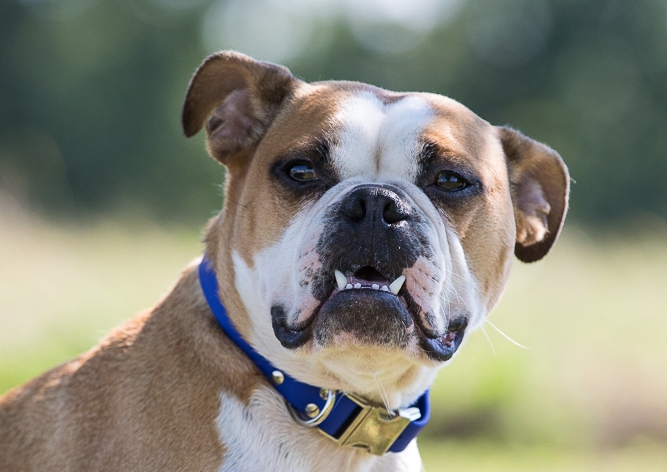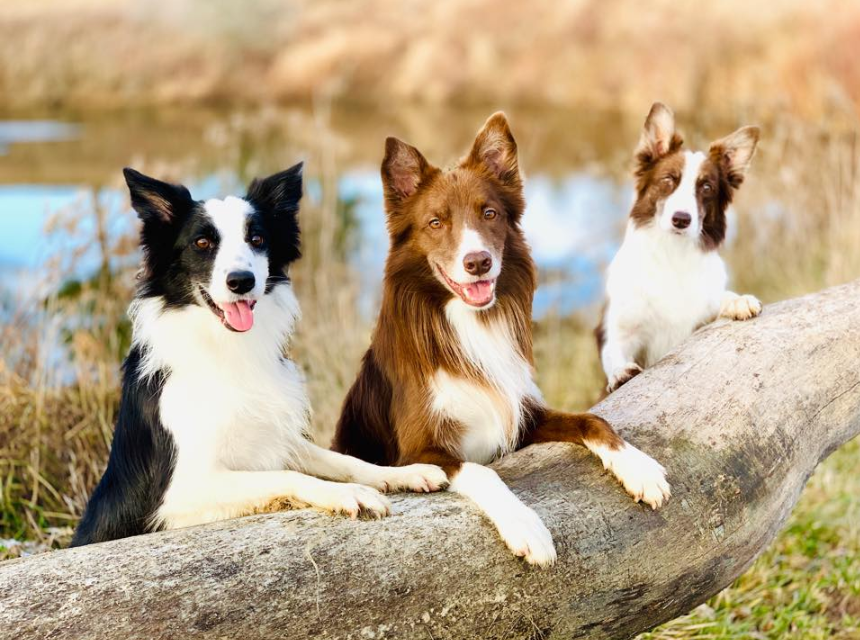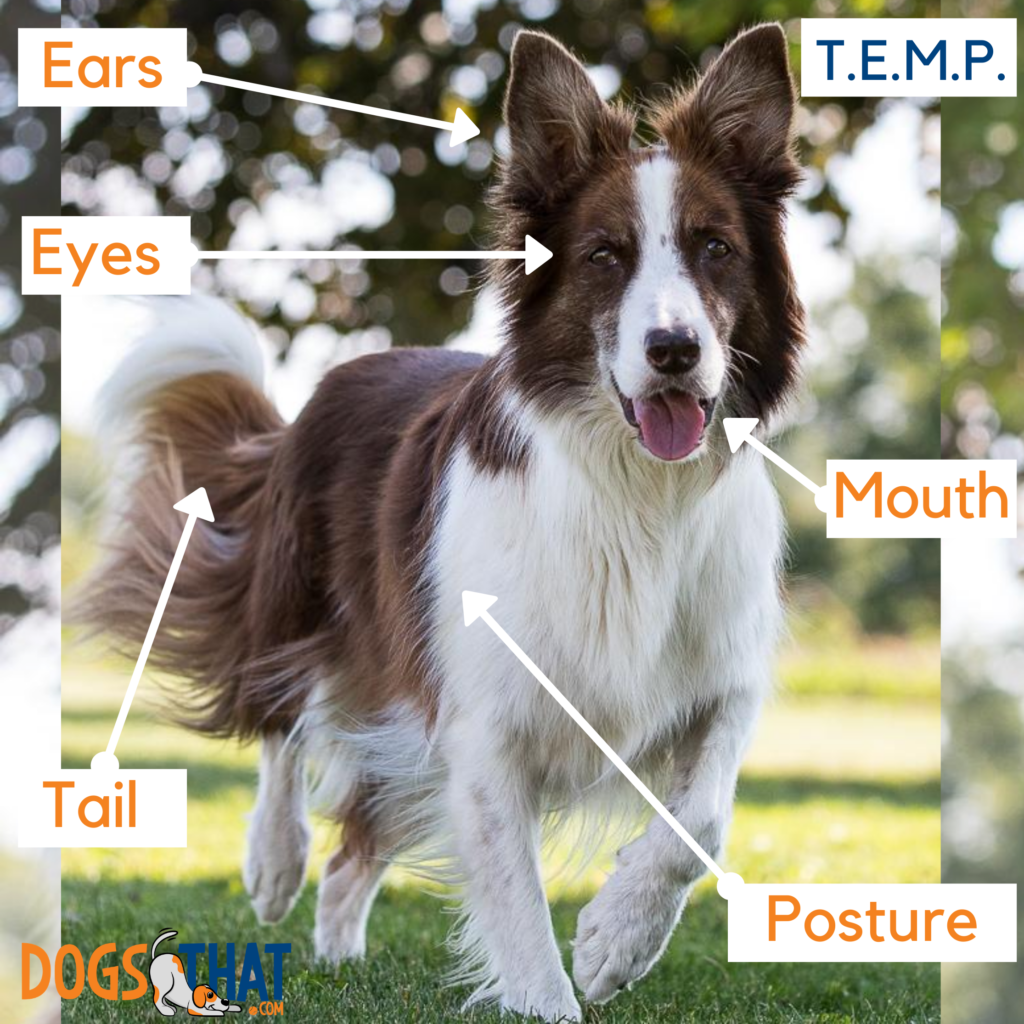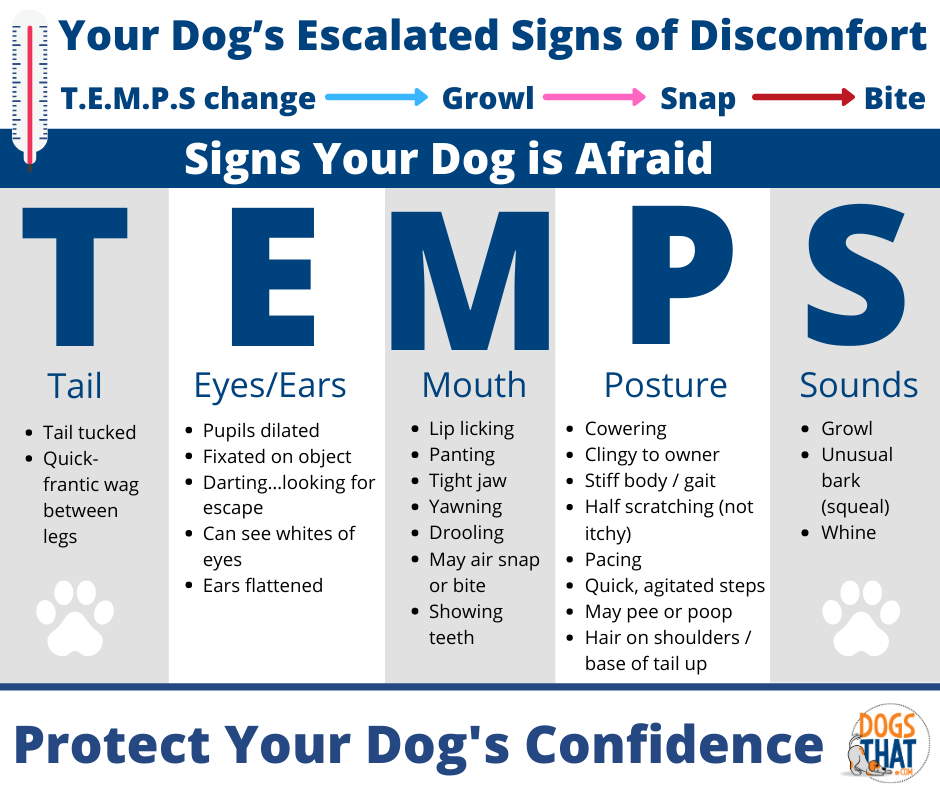One of the things people search for here on my blog is TEMP. It’s mentioned in several places and in videos, but I’ve never had a post specifically on T.E.M.P. That changes today! Dogs can’t talk to us, but they can communicate. Knowing what a dog is telling you is vital. Dogs have many signs to show what they are feeling.
T.E.M.P. is an acronym I believe I heard first from the late Dr. Sophia Yin. It stands for “Tail, Ears, Mouth, Posture”. I think of the “E” to be Ears / Eyes, but TEEMP is not as neat an acronym as TEMP.
T for Tail
The tail is fairly obvious. Many people will say “oh the tail’s wagging, happy dog”. Not necessarily. You’ve got to look at how the dog’s tail is wagging. Some dogs will wag their tail, and it creates an entire body wag, or it goes like a helicopter in a circular motion. That is a super happy dog. A lot of dogs will show different levels of happiness through a wagging tail.
Some dogs may tuck their tail and hold it up along their belly. You could say “maybe they’re cold”, but a lot of times that is a sign of anxiety, stress, or a lack of comfort with the situation. Or, a tail could be held very stiffly above the dog’s back, and that could be the dog getting a little bit more territorial. A tail that’s held low between the hocks and is wagging kind of frantically is not necessarily a happy tail. The low wag could be a nervous tail and could lead to problems if you don’t interpret that correctly.
A lazy wag back and forth with other good signs is generally a pretty good indication that the dog is confident and happy with the situation.
E for Eyes
If a dog’s eyes are full, bright, and alert, that’s a good sign. If you can see the whites of the eyes at the bottom, that’s not a good sign. Look at pupils, are they dilated, narrow, very, very small or very, very big? Depending on the light eyes may dilate but a narrowing of the eyes is a dog being more intent. Are the eyes darting side to side? Is the dog looking for an escape? Or is the dog staring? Staring is often a sign that a dog is intent on a target. Or perhaps the dog could be looking at something they are nervous about. Sometimes you see the eyes are almost closed to a slit. That happens a lot when dogs are being submissive, and the submissive dog is a dog who could be worried.
A dog with eyes that are moving naturally (like a person who is taking everything in) is a relaxed dog. A dog that has eyes are fixated is a dog who has intent on possibly pouncing and playing, or possibly attacking. A dog with darting eyes might be a dog who is not comfortable with the situation.
E for Ears
Obviously dogs have different earsets. Some dogs have a different set of each ear. Dogs like Labradors have floppy ears, my Border Collies have perky ears, and Tater-Salad has his own Tater ears. No matter what earset a dog has, you can see alertness with the ears ‘held high’. The muscles in the dog’s skull allow dogs to rotate ears in different positions. If one ear is up and one back, the dog is listening to something in behind or trying to ‘take in’ something behind. If the ears are up high on the head, the dog is confident or may be focused on something.
Ears brought together and pinned to the back of the head is often a sign that the dog is worried, or fearful. If the ears are turned to the side in what is often called “rose budding” (not to be mistaken for a rose ear set), and turned in a little bit, with the dog showing little slits of their eyes, that is a submissive posture. If the dog’s ears are flat and plastered to the back of their head, that’s not a comfortable or confident dog. You need to take in all of these things together with other elements of T.E.M.P. when reading a dog.
M for Mouth
Sounds
We’ll look as sounds first. Pay attention to the way a dog is vocalizing. Is there growling? Now, growling doesn’t mean a dog is aggressive; a lot of dogs will growl in play. So, don’t be concerned if when you’re playing with your dog they start growling. My dogs growl when they’re happily engaging with me.
However, growling with some of the other signs like seeing the whites of the eyes, or staring, or pinned ears are not a combination that means a dog is in a good place. That is a dog that is showing you discomfort. You need to listen to the growl!
It is IMPORTANT to note that growling may be absent because a lot of dogs are disciplined for growling… something you should never ever do! When a dog is repeatedly disciplined for growling, the dog will lose their voice, and you don’t ever want that to happen. A dog growling is saying “I’m not comfortable with the situation, please take me out of it.” This is vital information for your dog to tell you!
When you remove the growl from a dog, all that dog has left is a bite. The growl is an excellent indicator for you. When you hear it you want to make a plan to help condition the dog so they are more comfortable, but in the moment when you hear a growl, get your dog out of the situation.
Is the dog whining? Whining could be that a dog is stressed or anxious. Whining could be an overly excited dog as well. Is the dog barking? Barking could be happy. Barking could be alerting. If it’s a puppy barking, it could be that they’re just using their voice and that they’re happy. It’s important to look at all the elements of “T.E.M.P.” brought together when evaluating what a dog is telling you.
Physical Signs
Let’s consider physical signs involving a dog’s mouth. Is the dog showing teeth? If a dog is showing you a slit of their eyes, rose budded ears, and their teeth, they’re being submissive. Some breeds of dogs will naturally do that when a stranger is approaching. And remember, it’s not good to approach any dog you don’t know without asking their owner first. A lot of submissive dogs are super happy to see people. Still, maybe not all people and perhaps the dog is a little worried about children in particular. You have to ask the questions to find out.
Look at what the lips are doing. Are the lips relaxed and loose, or are they pursed? If they’re held back and pursed, the dog may be nervous. Many people think that the dogs who bite are the ones who are growling. Dogs who are nervous are as likely and maybe even more likely to bite. Bad signs are a dog who is lip licking, lip lifting, showing you their teeth, along with growling, pinning their ears, fixating their eyes. If a dog is nervous and can’t get out of a situation, their only defence is to nip. A nervous dog pulling back and holding their lips in a tight mouth is a dog who is showing you great discomfort.
Lip licking could be a calming signal that the dog is trying to give another dog, and it may be combined with a shake off. These are signs that dogs give other dogs to try and defuse the situation … “please can we all be friends here?”. Lip licking could be a sign that the dog is nervous. If a dog is licking their lip, averting their eyes, pinning their ears and tucking the tail, that dog is nervous, so give the dog space.
P for Posture
A dog who is relaxed will have low whole-body wag. Their tails wag and their bodies wag, and their ears are up and confident. You can see that the body wag is initiated from the tail.
A dog who is stiff with head up and fixed, and maybe has the hair on the back of the neck right around their shoulders and at the base of their tail up, is a dog who has been been triggered. They may be excited, they may be alarmed, they may be trying to make themselves big to protect themselves, but the dog is alert to something.
A dog who is crouching and low with their tail down could be a little worried about something. Certain breeds like Whippets, Italian Greyhounds, Greyhounds, naturally carry their tail low. Even some of my Border Collies might have their tail low between their legs, but that doesn’t necessarily mean that they’re nervous. You need to take all things into consideration.
A submissive dog might crawl and even turn the body sideways with a little frantic body wag. That is a dog who is not confident and might be slightly nervous but is showing you submission and saying “I’m not 100% sure about this situation but I really, really would like to experiment with it”. A dog may just flatten themselves to the ground if they’re not confident or if they are nervous.

Tater relaxed and taking things in.
Reading a Dog’s T.E.M.P.
You need to see the big picture. Dogs who are mentally sound, which is 99% of the dogs out there, are going to give you these signals in a predictable way. If for any reason you think your dog might fall outside of that 99% go straight to a Veterinary Behaviourist.
If a dog is growling but has a body wag to the side, is averting their eyes to the side, and shows rose budded ears and wagging their tail low, you are NOT going to rush in and pat that dog. But those signs do not necessarily mean the dog is going to lunge and attack you. A dog who is sore may give you a growl because they want to be left alone. You need to take in all of the information the dog is giving you. If you think your dog is sore, or has changes in his normal T.E.M.P. visit a Vet.
Dogs can’t talk to us, but they can communicate. Dogs communicate with their body and sounds, and that allows you to know what is going on. The worst thing that you can do is not believe what the dog is communicating. Our number one goal is to help our dog be confident.
Your Role to Help Dogs
Never approach a dog without asking their owner first. Teach your children to never approach a dog without asking their owner first. Even if you have permission, look at the dog’s T.E.M.P. and make good decisions for you or your child and the dog.
Some people think that having people pat nervous dogs will help the dog, and that is something we call flooding in science. But flooding can often backfire. If you own a dog who showing signs of not being confident or comfortable, a better thing to do is to keep that dog a distance away from their stressor where you can reinforce your dog yourself. Believe what your dog is communicating, Your dog is asking for your help, and as their owner, your number one job in life is to help your dog become more confident.
Never ever discipline a dog who’s growling. The dog is communicating, something very clear to you. As their owner, you need to get them out of that situation. Take note, go to a trained Veterinary Behaviourist and ask for help if you don’t know the next steps.
Supervise and Know Your Dog’s T.E.M.P.
Regardless of how “trustworthy” you believe your dog is, never leave any dog unsupervised near small children.
Ownership of a dog means that the dog trusts us to be their best advocate. This means recognizing your dog’s signs of stress and responding appropriately. Never “force” a dog to accept something when he is giving you clear warning signs that he is not comfortable. Remove your dog from the situation and work with him at an appropriate distance from the distraction.
Learn to take a dog’s T.E.M.P. as the signs are the only way dogs can communicate their acceptance of any situation. As a parent take the time to teach your children how to read these signs as well.
Respect What Your Dog is Communicating
Recognize any dog, when in “fear mode,” is a creature of fight or flight. Escape will be their first choice. When escaping is not possible a dog’s “fight” mode may kick in and can escalate from a low growl to a bite very rapidly. Never discipline your dog for growling as it is his only way to communicate his discomfort should you miss his previous T.E.M.P. signals.
Avoid creating anxiety by not allowing anyone to hug, push, poke, jump on, corner or quickly grab at your dog. As humans, we should always allow a dog the choice to interact with us, rather than forcing ourselves on him. It is a matter of socially appropriate behaviour on our part.
Once we are accepted by the dog, long strokes of the body or scratches of the neck and behind the ears is often the best way to show the dog affection. When a dog retreats away respect their decision and allow them to choose to come back if and when they feel comfortable doing so. Understand that any dog can move from comfortable to fearful very quickly. A great way to get a dog to be more comfortable is to change their state through play.
Resources
As I mentioned, I’ve covered T.E.M.P. before in many ways, and you can check out some of the key resources here on my blog and podcast.
- Video Blog: Dog Body Language, Fear and Aggression
- Video Blog: Understanding Your Dog’s Triggers
- Video Blog: Where Is Your Dog On The Circle Of Fun?
- Shaped By Dog Podcast Episode 4: T.E.M.P. (Tail, Eyes/Ears, Mouth, Posture)

Happy dogs Momentum, Swagger and Feature posing on a walk.
Can you tell when your dog is anxious and do you know when to remove your dog from a situation he is unequipped to handle? Do you know when your dog is confident and happy? Are you able to tell if your dog is engaged and happy when you are training (playing) together? Let me know in the comments!
Today I am grateful that Momentum and I are counting the days until we get to meet her puppies.








Very valuable info, thanks for sharing, Is it okay if I include some of this information and the two T.E.M.P diagrams in my university assignment on dog attacks? Thanks.
Hi Maria, can you please reach out at [email protected] so we can help? Thank you!
Great clear information, thank you. I have a lot of problems with my Tibetan Terrier regarding reactive aggression towards some other dogs and occasionally people who make him nervous. I have been to three different training groups but walking still becomes a difficult job which is a shame. I have learned not to show any nervousness to him when out and to try and keep him calm but he has a ‘hit list’ of certain dogs. It is very strange. Some he greets with friendliness but others he is very aggressive towards and I am constantly watching for Hesse dogs so we can avoid them otherwise he pulls to attack them. I have read that Tibetans are very jealous about other dogs getting too close to their owners so I have to watch this as it can occur when my daughter brings her dogs along. I have been told not to get him neutered as his testosterone helps him fight his fears but I feel that his reaction to some other dogs may not always be fear based. Have you any advice please?
I’d also be interested in understanding more of these signals in context of multi dog homes. My newest dog and one of the others circle each other which I am interpreting as pre- something or maybe too late. Anyway, I distract them with a command which solicits a treat.
Hi Annemarie – a bit more here on Susan’s Podcast about TEMP – https://dogsthat.com/podcast/4/
Thanks for the informative article. I am very worried when my dog has a fever. When the temperature gets abnormally high, my dog is always nervous and can’t calm down. Of course, at a high temperature I take my dog to the vet, because the temperature can be a sign of serious illness.
I have a dog that growls in happiness when I’m massaging him and I get the right spot. I don’t discipline for that because he’s communicating and giving me information. There is no menace in it.
Thank you for this invaluable information.
We are always wondering what they are feeling.
I knew some things and many things I did not know. I’m comparing reading the dogs temp with how I try to read my horses temp. It seems some actions are very obvious and I misread or don’t understand others. The dog is clear when intimidated by several big dogs wanting to greet her so I remove her to a place of more safety. She is clear she likes the hop it up and search games. I have tried to ask her to not bark at the neighbors dogs who are not responding or coming to run the fence. But Id like her bark more at folks at the door…but it’s ok she doesn’t. Lots to think about and thank you
When my dogs—all 4 of them — bark at something, I get up, look, tell them it’s ok and thank you. The exception is the animals on the TV. HELP! 😝. My son was going to use a shock collar which I hate — to stop his dog from barking. I agree with you 1000% I had a fit. You want your dog to bark! Thank you for all your information! This is the best training money I have ever spent!
When will you run agility at national again? I want to see your handing!!!
Very helpful information thanks
I hope all goes well with the whelping and the puppies.
Thanks Susan, that’s some great insights. Curious for your thoughts on ‘stalking’ posture? Is that more breed-related? Nero does this a lot on our beach walks, often from quite a distance!
Other dogs being stalked sometimes do it back in a Mexican stand off, but others seem to become afraid and distractions/moving away are the only way to break this behaviour.
My dog has a natural bob tail so I can only tell that its wagging fast or slow. When excited he wiggles his whole bum. Any way to read this sign in a bob tail?
EXCELLENT! THANKS grand mum to be! 🙂
I have a young Golden who, when asked to look at me, will often look to the sky or the ceiling. Is this avoidance? If wanting the back gate open she looks upward toward the sky. When wanting a cookie while I’m in the bathroom (yes, I train in the bathroom), she looks to the ceiling after she has ‘touched’ the cookie jar. I am assuming this is just her way of communicating. She also has bad habit of running to another dog and then being very submissive; on her belly, head down. Is there a way to help her through this? Not going to be great in the obedience ring.
Great article. You are so well-respected that people who read this will come away learning much about the growl, especially. We need so much to “listen” to our dogs! Thank you AND. CONGRATULATIONS on your upcoming litter!!!!!!!
Awesome info thank you
Thank you, sharing with my husband as he doesn’t understand my refusal to allow anyone to approach and pet my dogs. 2 of the 3 would be fine, but my older female is not a fan of strangers coming up to her while she’s on leash. I don’t want to shake hands with every person I pass, so why should my dogs be expected to be greeted by everyone. He just feels bad when I say “I’m sorry, but no you can’t pet my dogs” to kids.
Great information, Thank You.
I fully agree!!! 🙂 I had a rescue dog that I got at 6months old. She had food and attention aggression with other dogs. She would bite without a growl. Eventually she did learn to growl. One could never really trust her though. She would seem calm and comfortable and trustworthy but if another dog came into her space, they would end up with a hole. She was a good dog in many ways and lived to the ripe old age of 16+. I couldn’t agree more with don’t take away the growl.
Here’s a picture of Night on our walk yesterday. What is his TEMP saying, definitely something…oh, I guess I can’t attach a photo. Anyway, we were on a walk, we saw a deer lying down. On the way back through I had been wanting a picture of Night with the deer in the background. I got that picture yesterday. His ears are back, eyes are like “what’s going on” not his best picture but definitely you can read that he knows something is back there and he’s not overly happy with his back to it but does comply.
Have a great day, Congrats on the upcoming litter.
Thank you
Very interesting enjoyed the article.
Will share this with my dog training clients, thank you! You’re the best!
I never knew all that but im glade i do now i have two female Huskies. There wonderful dogs. Mom and daughter. Mom 5 daughter 2 both fix. My husband was mad when i fix the daughter. She a sliver color. We walk them morning and nite there inside with use wont have it any orther way
This is invaluable. Sam, Delilah and I thank you!
stf